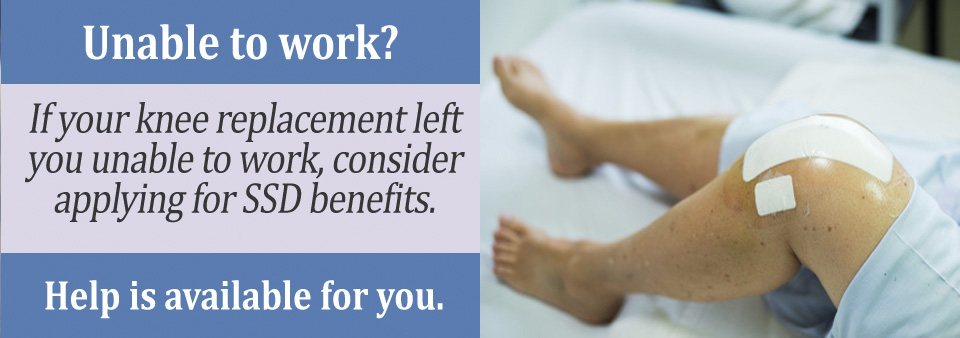According to data from Ortho Info, more than 600,000 knee replacements are performed each year in the United States. Of these, around 90% report improvement over the next few months of recovery.
However, for the 10% who do not see improvement, pain can persist, recovery stretches on, and on rare occasions, symptoms can get even worse.
If you are struggling to return to an independent lifestyle after knee surgery, you may qualify for financial assistance through Social Security disability insurance. Below, we will learn how to understand the qualification process, and how you can begin preparing for your application.
Qualifying With the Blue Book
In order to qualify for disability benefits, the Social Security Administration (SSA) must decide that an applicant is “totally and permanently disabled."
This is done by comparing the applicant’s symptoms to their disorder’s listing in the SSA’s “Blue Book.” This medical compendium can be viewed online at any time.
Knee replacements are listed under “Musculoskeletal System Disorders” in the Blue Book, under subsection 1.03: “Reconstructive Surgery or Surgical Arthrodesis of a Major Weight-bearing Joint.” Here, the book states that you can qualify for benefits if you:
- have had surgery on a major weight-bearing joint (such as the knee)
- are unable to ambulate effectively (can’t walk without assistive devices, can’t walk safely for a normal length of time, etc.)

While this entry may look rather simple at first, it can be a bit tricky to qualify for benefits under this listing. For one, knee replacement surgeries typically do not cause complications for more than a year.
If it has been less than a year since your surgery, it can also be difficult to get a diagnosis from a doctor stating that you will remain impaired after this time. If you are worried about whether or not you may qualify under this listing, you may still be eligible for benefits under a Medical Vocational Allowance.
Medical Vocational Allowances
A Medical Vocational Allowance (MVA) is for people whose conditions do not meet a Blue Book listing but are still severe enough to keep them from working.
MVAs are typically awarded to applicants who are well into adulthood, who have other medical troubles, who have little education, and/or who have only trained or had one job for their entire lives. The more your condition prevents you from doing the work you know how to do, the greater your likelhood of qualifying for an MVA.
For example: say a woman applies for benefits after a knee replacement. She has a GED, has spent her whole life as a chef, and would have great difficulty finding other work during recovery.
Because complications from her knee surgery prevent her from safely working in a kitchen (the only job she has substantial experience in), she may be eligible for an MVA.
Preparing for the Application
The most important part of your disability application is ensuring you have all the right paperwork. Before you apply, be sure to have the following paperwork ready to be included in your application:
- MRI/CT scans: Scans from any and all points of your medical history are required here. This can help the SSA understand the extent of your diagnosis before surgery and compare this to the lack of improvement post-surgery.
- Current and past treatment attempts: It is important to show the SSA what other forms of treatment you’ve tried to improve your knee post-surgery, such as medication, physical therapy, or braces. The more you’ve attempted to fix your complications, the more likely the SSA will understand your need for assistance.
- General medical history:Go back to the point when you first started seeking treatment for your knee problems. Include physician’s notes and check-up reports up until the closest date before you applied
- Residual Functional Capacity test: RFC tests are especially necessary if you believe you may need an MVA. These tests measure your ability to perform required daily movements like standing, sitting, walking, pushing, pulling, lifting, or bending. The less you are able to function, the greater the likelihood that you will qualify for benefits.
Working With a Disability Attorney
In difficult cases such as knee replacement cases, it is common to see your first application denied. After this, there is more paperwork and preparation required to present your case in front of an administrative law judge.
Whether you’re in this appeal phase or still looking to apply, it may be wise to consider a free consultation with a disability attorney. His or her expertise in this area can help you organize paperwork, build a strong case, and give you the best chance of receiving the financial assistance you need.
Your disability claim can be denied twice and you can appeal those rulings. The final step is to request a hearing before an administrative law judge who will rule on the findings presented in the case.